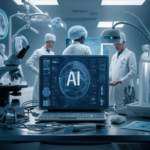The Role of AI in Weather Prediction
Weather forecasting has traditionally relied on complex mathematical models that simulate atmospheric conditions. These models, known as numerical weather prediction (NWP) models, use a vast amount of data gathered from satellites, weather stations, and ocean buoys. While these methods have improved over the decades, predicting hurricanes—especially their intensity and path—remains challenging due to the chaotic nature of weather systems.
AI, particularly machine learning (ML) and deep learning (DL) models, can analyze vast amounts of data more efficiently and recognize patterns that might be missed by traditional approaches. By integrating data from various sources, including satellite imagery, historical weather patterns, ocean temperatures, and wind conditions, AI models can provide more accurate and earlier predictions of hurricane formation and trajectory.
AI-Driven Forecasting Models
Several AI-driven models are already being tested and used to improve hurricane forecasting. For instance:
- IBM’s Watson and The Weather Company: Watson’s AI platform is being leveraged to analyze vast datasets in real-time, providing more accurate and timely forecasts. This AI-powered system can detect changes in weather patterns earlier than traditional methods, offering extended lead times for hurricane warnings.
- DeepMind’s Neural Networks: DeepMind, a subsidiary of Alphabet, has used its neural network capabilities to predict weather patterns. While its primary focus has been short-term weather predictions, the technology has the potential to be applied to hurricane forecasting, especially in predicting sudden changes in a storm’s intensity or path.
- NOAA’s Hurricane AI Models: The National Oceanic and Atmospheric Administration (NOAA) has been experimenting with machine learning algorithms to improve the accuracy of its hurricane predictions. These models help refine NWP data by correcting systematic biases and enhancing predictions of storm intensity and rainfall.
Early Warnings and Evacuations
One of the most significant advantages AI offers is the potential for earlier and more precise warnings. By detecting patterns that suggest the formation of hurricanes earlier, authorities can issue warnings days in advance, giving populations more time to prepare and evacuate.
AI can also be used to predict where a hurricane will cause the most damage, helping emergency responders and governments prioritize resources. For example, AI models can predict storm surges, coastal flooding, and which communities are at the highest risk. This targeted approach can enhance disaster response efforts, saving lives and reducing economic losses.
Challenges
While AI offers many benefits in hurricane prediction, it also comes with challenges. AI models rely heavily on the quality and quantity of data. In some regions, particularly in developing countries, there may be gaps in weather monitoring infrastructure, leading to less accurate predictions.
Moreover, AI is only as good as the data it is trained on. If historical data is flawed or incomplete, predictions could be skewed. Therefore, continuous efforts to improve data collection and the AI models themselves are crucial.
Ethically, there are concerns about the transparency and explainability of AI-driven forecasts. While traditional weather models are well-understood by meteorologists, some AI models, especially deep learning algorithms, are often considered “black boxes.” If an AI model provides a prediction, but the reasoning behind it is unclear, it could raise trust issues among scientists and decision-makers.
Future Prospects: AI and Satellite Technology
One of the most exciting frontiers for AI-driven hurricane prediction is its integration with satellite technology. With advancements in satellite sensors and data processing, AI can analyze real-time data from space to track storm formation more accurately. This integration will lead to better early warning systems and could help prevent disasters before they occur.
For example, NASA’s upcoming missions, which include deploying new Earth observation satellites, will provide unprecedented amounts of data on weather systems. Coupled with AI’s ability to process and learn from this data, the future of hurricane prediction looks more promising than ever.
AI is rapidly transforming the way we predict hurricanes, offering the potential to provide earlier, more accurate warnings that could save lives and mitigate damage. However, for AI to reach its full potential in this domain, continued improvements in data collection, model transparency, and global cooperation are essential. As we face a future with more frequent and intense hurricanes, AI may prove to be a vital tool in humanity’s ability to adapt and respond to these powerful natural events.
In short, while AI won’t stop hurricanes, it will help us be better prepared—and that can make all the difference in saving lives and communities.
. Related articles .
 Will AI Be a Guardian or a Threat to the Doomsday Clock?
Will AI Be a Guardian or a Threat to the Doomsday Clock?
 The AI World Index: A Vital Tool for Navigating the Global AI Landscape
The AI World Index: A Vital Tool for Navigating the Global AI Landscape
 The Role of AI in Medical Diagnostics
The Role of AI in Medical Diagnostics
 The Future of AI Education: Preparing the Next Generation of Innovators
The Future of AI Education: Preparing the Next Generation of Innovators
 Can AI Bring Down the Price of Oil? A Macro-Economic Perspective
Can AI Bring Down the Price of Oil? A Macro-Economic Perspective
 Book Review: Nexus: Where History, Technology, and the Future of Humanity Converge
Book Review: Nexus: Where History, Technology, and the Future of Humanity Converge
 AI’s New Pioneers: Hinton and Hopfield Awarded 2024 Nobel Prize for Revolutionizing Neural Networks
AI’s New Pioneers: Hinton and Hopfield Awarded 2024 Nobel Prize for Revolutionizing Neural Networks
 The Automation Paradox: Could AI Be Slowing Its Own Growth?
The Automation Paradox: Could AI Be Slowing Its Own Growth?
 Nobel Prize in Chemistry Awarded for AI Breakthrough in Protein Research
Nobel Prize in Chemistry Awarded for AI Breakthrough in Protein Research
 The Future of Buying and Selling AI Robots: A Market Like Cars?
The Future of Buying and Selling AI Robots: A Market Like Cars?